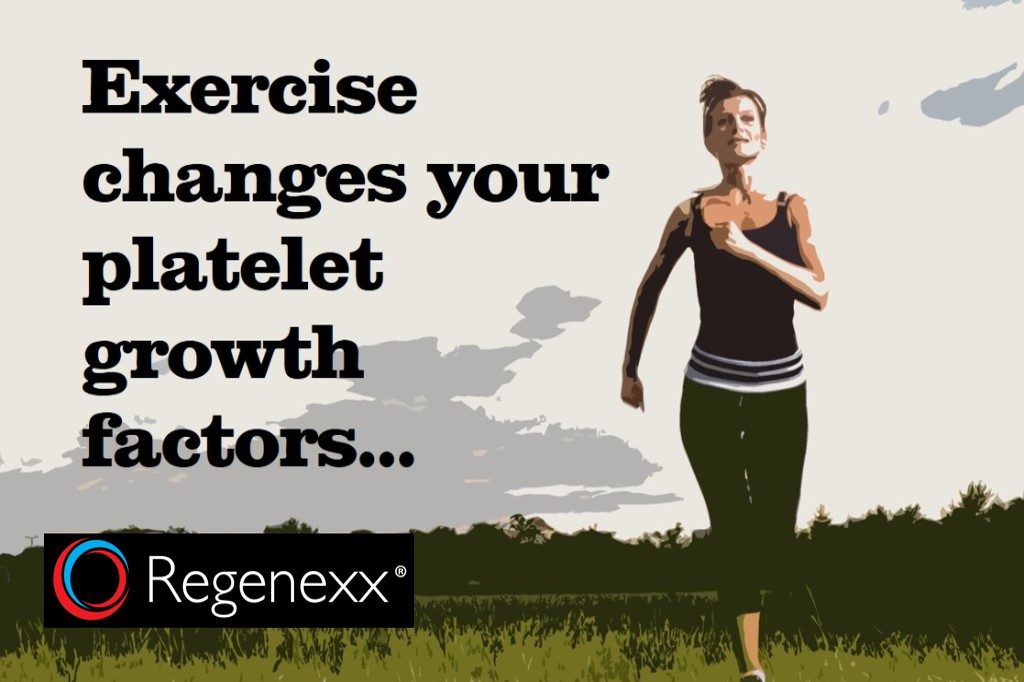Exercise Changes Growth Factors in Platelets
Love it or hate it, exercise seems to be one of the areas where we can make the most significant impact on our health. We know exercising and keeping our weight under control have a lot to do with the chemical environment within our joints, but can exercise impact the makeup of the PRP made from our blood to treat those joints? With no published studies on the subject, a research team in Qatar put together a study to determine if exercise changes Platelet Growth Factors in PRP.
Growth factors found in Platelets are the active ingredient in PRP, pretty much the same way that caffeine is in coffee. It’s the growth factors that stimulate the local stem cells to wake up and do their job. There are IGF’s which are insulin like growth factors, HGF’s which are hepatocyte growth factors, PDGF’s of various A and B types which are Platelet Derived Growth Factors, and VEGF’s which are Vascular Endothelial Growth Factors (to name a few). Each of these growth factors do different things but work together to stimulate healing. In your body, this system kicks into gear when you bleed into a wound, which activates the platelets to clot the area and also prompts them pumping out these and other growth factors. This is why doctors have begun to use PRP to amp up healing in an area that hasn’t been able to heal on it’s own.
The study used 10 healthy subjects who performed an hour of moderate exercise and had their blood drawn immediately before, immediately after, and 18 hours after. PRP was made from each of the blood samples, and the growth factor content of the platelets were analyzed. The results showed that exercise does significantly impact Platelet Derived Growth Factors in PRP by significantly reducing the concentrations of VEGF and PDFG-AB. Concentrations of IGF1 and HGF were unchanged.
Does it make sense that the concentration of two of the growth factors in platelets would go down? The body principle of homeostasis is likely at play. VEGF is responsible in the body for making new blood vessels. It may go down to offset the fact that exercise itself produces more blood vessels in tissue. PDGF has in part the same function, so again it’s likely being down regulated for the same reason. PDGF is also a potent stimulator of cell division as is exercise, so again this may be the body working hard to keep the repair response balanced. In addition, a growth factor only works with a receptor on a cell and it could be that exercise increases the number of those receptors on cells, requiring less growth factor to get the same level of cell stimulation.
The upshot? Growth Factors are incredible things. The thing is, you want higher concentrations of certain ones and lower concentrations of others. We’ve extensively tested growth factor concentrations in many types of platelet preparations including various types of super concentrated platelet rich plasma and lysates. We’ve seen age have a big effect, with declining overall growth factors. On the other hand, we’ve seen evidence that older patients have more receptors on cells for these growth factors leading to a bigger stem cell response to the same levels of growth factors than younger people. So while a drop in certain growth factors with exercise might seem counter intuitive, it may just be the body’s way to offset for things like cells that work better when the “caffeine” of the body comes knocking!

NOTE: This blog post provides general information to help the reader better understand regenerative medicine, musculoskeletal health, and related subjects. All content provided in this blog, website, or any linked materials, including text, graphics, images, patient profiles, outcomes, and information, are not intended and should not be considered or used as a substitute for medical advice, diagnosis, or treatment. Please always consult with a professional and certified healthcare provider to discuss if a treatment is right for you.

